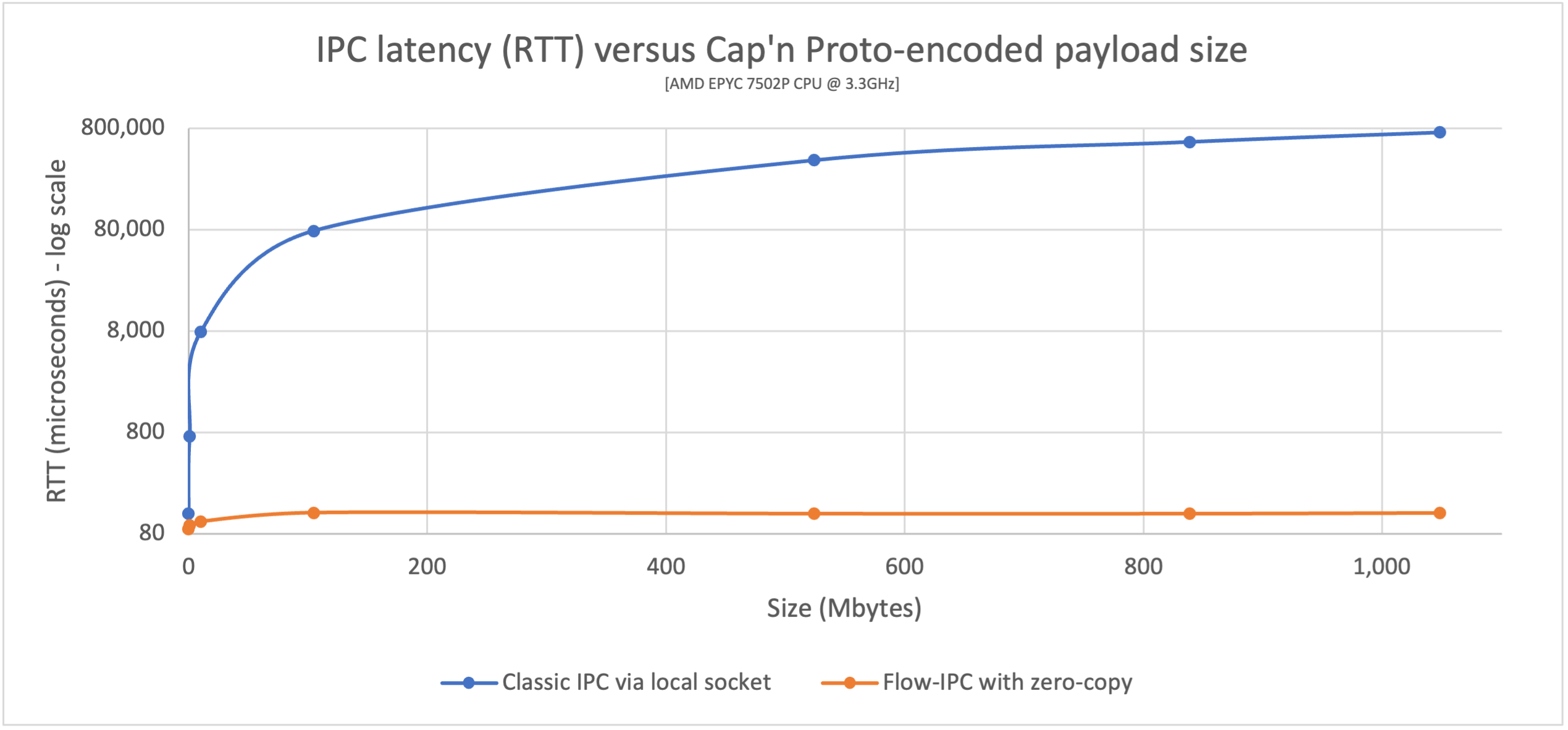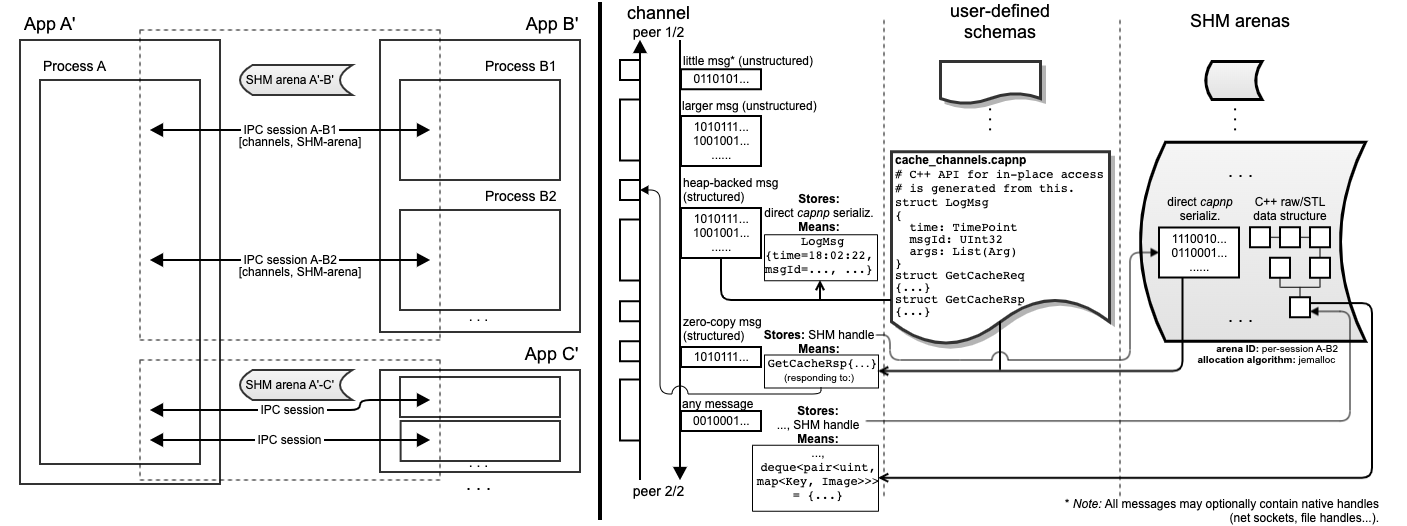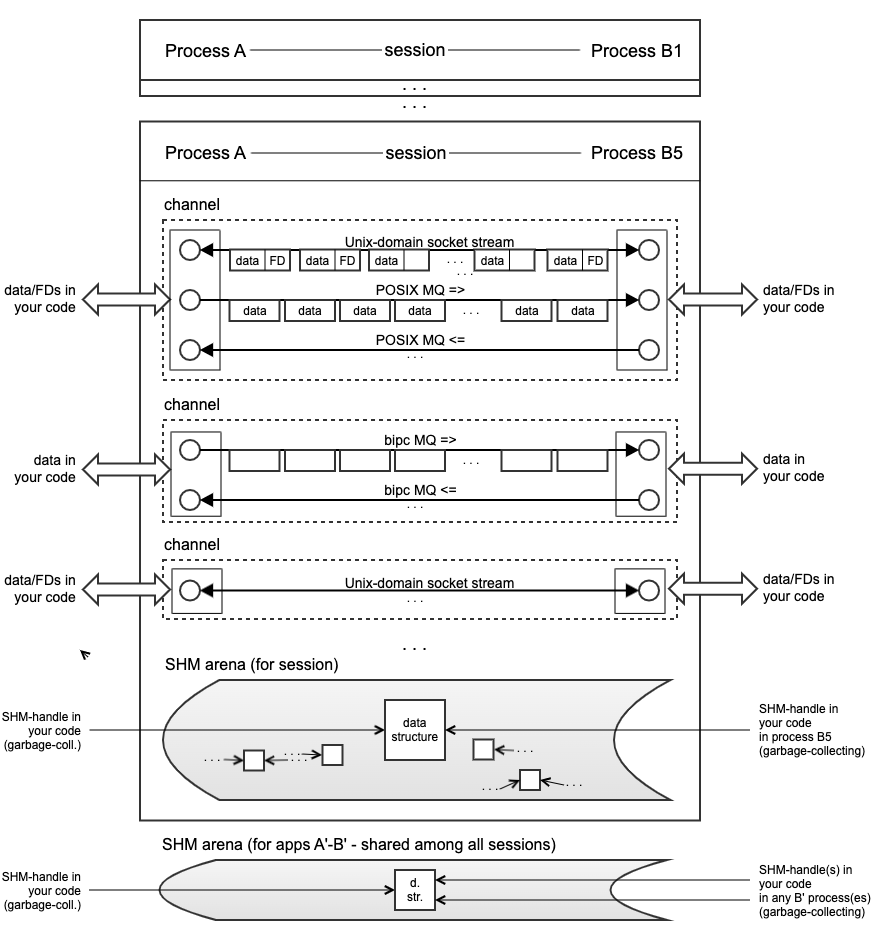In this context, IPC means the sharing or transmission of a data structure from one process to another. In C++ systems programing, this is a common activity with significant impact on system performance. E.g., it is used heavily in microservices.
In serious C++ applications, high-performance IPC code tends to be difficult to develop and reuse, and the most obvious and effective technique to combat latency -- avoiding copying -- further increases the difficulty and decreases reusability by an order of magnitude.
This project -- Flow-IPC -- enables C++ code for IPC that is both performant and easy to develop/reuse, with no trade-off between the two.
Flow-IPC is for C++17 (or higher) programs built for Linux that run on x86-64 processors. (Support for macOS/BSD and ARM64 is planned as an incremental task. Adding networked IPC is also a natural next step, depending on demand.)
The guided Manual explains how to use Flow-IPC. A comprehensive Reference is inter-linked with that Manual.
The project web site contains links to documentation for each individual release as well.
Please see below, in this README, for a Primer as to the specifics of Flow-IPC.
- As a tarball/zip: The project web site links to individual releases with notes, docs, download links.
- Via Git:
git clone --recurse-submodules git@github.com:Flow-IPC/ipc.git- Note: Don't forget
--recurse-submodules.
- Note: Don't forget
See INSTALL guide.
See CONTRIBUTING guide.
Flow-IPC focuses on IPC of data structures (and native sockets a/k/a FDs). I.e., the central scenario is: Process P1 has a data structure X, and it wants process P2 to access it (or a copy thereof) ASAP.
The OS and third-parties already avail C++ developers of many tools for/around IPC. Highlights:
- Pipes, Unix domain socket streams, message queues (MQs), and more such IPC transports allow transmitting data (binary blobs and sometimes FDs). Data are copied into the kernel by P1, then out of the kernel by P2.
- P1 can put X into shared memory (SHM) and signal P2 to access it directly there, eliminating both copy-X operations.
- Zero-copy schema-based serialization tools, the best of which is Cap'n Proto, hugely help in representing structured data within binary blobs.
Conceptually, the IPC op above is not so different from triggering a function call with argument X in a different
thread -- but across process boundaries. Unfortunately, in comparison to triggering F(X) in another thread
in-process:
- The resulting machine code is much slower, using more processor cycles and memory.
- The source code to achieve it is much more difficult to develop and reuse, even with the help
of powerful APIs including Boost.interprocess and Boost.asio.
- If one wishes to avoid copying X -- the basic cause of the slowness -- one must use SHM to store X. This increases the difficulty 10-fold, and the resulting code is rarely reusable.
With Flow-IPC, the above IPC op is easy to code, for any form of "X," whether: blobs, FDs, nested STL-compliant
containers, C-style structs with pointers, or Cap'n Proto schema-based structured data.
Moreover, it eliminates all copying of X -- which results in the best possible performance. This is called end-to-end zero-copy.
The graph above is an example of the performance gains you can expect when using Flow-IPC zero-copy transmission, from
the included perf_demo tool. (Here we use Cap'n Proto-described data. Native C++ structures have a similar
performance profile.) In the graph, we compare the RTTs (latencies) of two techniques, for transmitted payloads
of various sizes.
- The blue line shows the latency (RTT) when using "classic" IPC over a Unix-domain stream socket. The server
::write()s the capnp-generated serialization, in order, into the socket FD; the client::read()s it out of there. - The orange line shows the RTT when using Flow-IPC with zero-copy enabled.
In this example, app 1 is a memory-caching server that has pre-loaded into RAM a few files ranging in size from 100kb to 1Gb. App 2 (client) requests a file of some size. App 1 (server) responds with a single message containing the file's data structured as a sequence of chunks, each accompanied by that chunk's hash:
# Cap'n Proto schema (.capnp file, generates .h and .c++ source code using capnp compiler tool):
$Cxx.namespace("perf_demo::schema");
struct Body
{
union
{
getCacheReq @0 :GetCacheReq;
getCacheRsp @1 :GetCacheRsp;
}
}
struct GetCacheReq
{
fileName @0 :Text;
}
struct GetCacheRsp
{
# We simulate the server returning files in multiple equally-sized chunks, each sized at its discretion.
struct FilePart
{
data @0 :Data;
dataSizeToVerify @1 :UInt64; # Recipient can verify that `data` blob's size is indeed this.
dataHashToVerify @2 :Hash; # Recipient can hash `data` and verify it is indeed this.
}
fileParts @0 :List(FilePart);
}
# ...App 2 receives the GetCacheRsp message and prints the round-trip time (RTT): from just before sending
GetCacheReq to just after accessing some of the file data (e.g. rsp_root.getFileParts()[0].getHashToVerify() to
check the first hash). This RTT is the IPC-induced latency: roughly speaking the time
penalty compared to having a monolithic (1-process) application (instead of the split into app 1 and app 2).
Observations (tested using decent server-grade hardware):
- With Flow-IPC: the round-trip latency is ~100 microseconds regardless of the size of the payload.
- Without Flow-IPC: the latency is about 1 millisecond for a 1-megabyte payload and approaching a full second
for a 1-gigabyte file.
- Also significantly more RAM might be used at points.
- For very small messages the two techniques perform similarly: ~100 microseconds.
The code for this, when using Flow-IPC, is straighforward. Here's how it might look on the client side:
// Specify that we *do* want zero-copy behavior, by merely choosing our backing-session type.
// In other words, setting this alias says, “be fast about Cap’n Proto things.”
// (Different (subsequent) capnp-serialization-backing and SHM-related behaviors are available;
// just change this alias’s value. E.g., omit `::shm::classic` to disable SHM entirely; or
// specify `::shm::arena_lend::jemalloc` to employ jemalloc-based SHM. Subsequent code remains
// the same! This demonstrates a key design tenet of Flow-IPC.)
using Session = ipc::session::shm::classic::Client_session<...>;
// IPC app universe: simple structs naming and describing the 2 apps involved.
// - Name the apps, so client knows where to find server, and server knows who can connect to it.
// - Specify certain items -- binary location, user/group -- will be cross-checked with the OS for safety.
// - Specify a safety/permissions policy, so that internally permissions are set as restrictively as possible,
// but not more.
// The applications should share this code (so the same statement should execute in the server app also).
const ipc::session::Client_app CLI_APP
{ "cacheCli", // Name.
"/usr/bin/cache_client.exec", CLI_UID, GID }; // Safety details.
const ipc::session::Server_app SRV_APP
{ { "cacheSrv", "/usr/bin/cache_server.exec", SRV_UID, GID },
{ CLI_APP.m_name }, // Which apps may connect? cacheCli may.
"", // (Optional path override; disregard.)
ipc::util::Permissions_level::S_GROUP_ACCESS }; // Safety/permissions selector.
// ...
// Open session e.g. near start of program. A session is the communication context between the processes
// engaging in IPC. (You can create communication channels at will from the `session` object. No more naming!)
Session session{ CLI_APP, SRV_APP, on_session_closed_func };
// Ask for 1 communication *channel* to be available on both sides from the very start of the session.
Session::Channels ipc_raw_channels(1);
session.sync_connect(session.mdt_builder(), &ipc_raw_channels); // Instantly open session -- and the 1 channel.
auto& ipc_raw_channel = ipc_raw_channels[0];
// (Can also instantly open more channel(s) anytime: `session.open_channel(&channel)`.)
// ipc_raw_channel is a raw (unstructured) channel for blobs (and/or FDs). We want to speak capnp over it,
// so we upgrade it to a struc::Channel -- note the capnp-generated `perf_demo::schema::Body` class, as
// earlier declared in the .capnp schema.
Session::Structured_channel<perf_demo::schema::Body>
ipc_channel{ nullptr, std::move(ipc_raw_channel), // "Eat" the raw channel object.
ipc::transport::struc::Channel_base::S_SERIALIZE_VIA_SESSION_SHM, &session };
// Ready to exchange capnp messages via ipc_channel.
// ...
// Issue request and process response. TIMING FOR ABOVE GRAPH STARTS HERE -->
auto req_msg = ipc_channel.create_msg();
req_msg.body_root()
->initGetCacheReq().setFileName("huge-file.bin"); // Vanilla capnp code: call Cap'n Proto-generated-API: mutators.
const auto rsp_msg = ipc_channel.sync_request(req_msg); // Send message; get ~instant reply.
const auto rsp_root = rsp_msg->body_root().getGetCacheRsp(); // More vanilla capnp work: accessors.
// <-- TIMING FOR ABOVE GRAPH STOPS HERE.
// ...
verify_hash(rsp_root, some_file_chunk_idx);
// ...
// More vanilla Cap'n Proto accessor code.
void verify_hash(const cache_demo::schema::GetCacheRsp::Reader& rsp_root, size_t idx)
{
const auto file_part = rsp_root.getFileParts()[idx];
if (file_part.getHashToVerify() != compute_hash(file_part.getData()))
{
throw Bad_hash_exception(...);
}
}In comparison, without Flow-IPC: To achieve the same thing, with
end-to-end zero-copy performance, a large amount of difficult code would be required, including management of
SHM segments whose names and cleanup have to be coordinated between the 2 applications. Even without
zero-copy -- i.e., simply ::write()ing a copy of the capnp serialization of req_msg to and ::read()ing
rsp_msg from a Unix domain socket FD -- sufficiently robust code would be non-trivial to write in comparison.
The preceding example was chosen for 2 reasons:
- Performance: It demonstrates the performance benefits of end-to-end zero-copy.
- capnp integration: It shows what it's like to transmit capnp-encoded structures using Flow-IPC, plus a look at session/channel management and (glancingly) Flow-IPC channel features like request/response.
Yes... but only among other things!
- It transmits native C++ data structures (including STL-compliant containers and pointers); native handles (FDs);
and (at a lower layer) binary blobs. Schema-based data structures are not always an ideal representation for many
algorithms!
- Without Flow-IPC: Transmitting such objects "by hand" ranges from annoying (blobs) to super-annoying (FDs) to really, really difficult (STL-compliant nested structures).
- It makes opening IPC communication channels (and SHM arenas if desired) easy. One side of this
is demonstrated in the above example: Merely name your two apps and open a session.
Now channels can be opened/closed at any time, and/or ready at session start (as shown above).
- Without Flow-IPC: You must name ~every socket and MQ and SHM segment, and this name must be known on both sides
but not conflict; you must arrange a connect-accept setup of some kind; open/create (and later clean-up) SHM
segments; invoke
mmap(). It is a ton of busy-work with many corner cases.
- Without Flow-IPC: You must name ~every socket and MQ and SHM segment, and this name must be known on both sides
but not conflict; you must arrange a connect-accept setup of some kind; open/create (and later clean-up) SHM
segments; invoke
- For safety/auth, one specifies 1 of 3 presets that will govern permissions settings applied to various OS object
underneath: unrestricted, shared-user (all applications have same user ID), or shared-group (all applications
have same group ID but differing user IDs).
- Without Flow-IPC: Sometimes treated as an afterthought, serious server applications need to specify permission masks on each individual OS object (SHM segment handle, POSIX MQ handle, stream-socket, etc.).
Flow-IPC provides API entry points at every layer of operation. Flow-IPC is not designed as merely a "black box" of capabilities. E.g., for advanced users:
- Various lower-level APIs, such as low-level transports (Unix domain sockets, MQs) and SHM operations, can be
accessed directly. You can also plug-in your own transports.
- (Networked channels and sessions are in the works.)
- By implementing/accessing some of the handful of key C++ concepts, you can customize behaviors at all layers, including serialization-memory backing, additional SHM providers, and C-style native data structures that use raw pointers.
If the example and/or promises above have piqued your interest:
A little complete example transmits
(with zero-copy) a structured message containing the string Hello, world! and the number 42.
In the Manual, the API Overview / Synopsis summarizes (with code snippets) what is available in Flow-IPC.
These diagrams from the Manual might also be helpful in showing what's available and/or some of what is going on underneath.
Here's a bird's eye view of Flow-IPC (left) and a compact exploration of a single Flow-IPC channel (right). (Click/tap to zoom.)
- On the left -- Flow-IPC's mission: applications speaking to each other performantly, in organized fashion. The infrastructure inside the dotted-line boxes is provided by Flow-IPC. Perhaps most centrally this offers communication channels over which one can transmit messages with a few lines of code.
- On the right -- zooming into a single channel; and how it transmits data of various kinds, especially without
copying (therefore at high speed).
- "capnp" stands for Cap'n Proto.
- This diagram is a survey of what and how one could transmit via Flow-IPC; different details might appeal to different users.
- Ultimately, if you've got a message or data structure to share between processes, Flow-IPC will let you do it with a few lines of code.
The following diagram delves deeper, roughly speaking introducing the core layer of ipc::transport.


